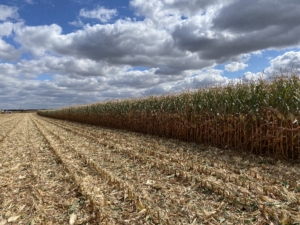
It won’t be long now and the combines will be rolling…..(don’t get nervous….not a current picture!)
Topics:
- Growing Degree Day Update/Weather Update
- Current Corn Conditions….
- Stalk Rots/ Windstorms/ Tall Ear Heights = Prioritizing Harvest!
- Current Soybean Conditions….
As of September 8th, we have accumulated approximately the following for Growing Degree Units in 2021:
Planting Date GDU’s2021 Average GDU Departure from average
April 24 2714 2465 +249 (+13 days)
April 30 2660 2428 +232 (+12 days)
May 6 2581 2375 +206 (+10 days)
As you can see, we are way ‘ahead of the game’ on GDU accumulation for this year. We are a solid 10-14 days ahead of normal and a tick ahead of 2020 by about 2 days or so. This is across all planting dates. From the above GDU numbers, we have almost enough accumulated to mature hybrids like 1366 and more than enough to mature shorter season hybrids, if planted on April 24th; and even early maturity hybrids have enough GDU accumulated, if using a May 6 planting date. Current seven day forecast should give us another 100-120 GDU’s. By the raw numbers then, we will have accumulated enough GDU’s to mature even hybrids like 1563 and fuller by first of next week if using an April planting date.
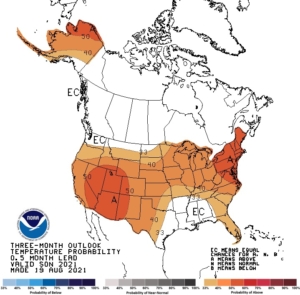
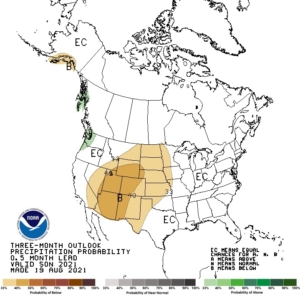
The above maps are the 3-month temperature and precipitation forecasts. If this holds true, we will have a drier and warmer than average harvest season.
Current Corn Conditions…..
- Much of the corn crop is as follows: April 24 planting dates – 105-110 day hybrids 7/8-3/4 milk lines with some almost black layer – 112-118 day 1/2 to 2/3. Later planting dates are 1/4 to 1/2 for the most part. Majority of crop is 1/2 to 2/3 milk line. Most fields will take another 7-14 days to finish meaning we are still seeing an extended grain fill period even though we are much further ahead than normal by the raw GDU numbers.
- So far staygreen in the irrigated is holding up for now, but starting to see some ears droop on the irrigated along with very late-season N deficiency….this weekend’s heat will speed this process up. Having a good soil moisture profile will slow this process, but not stop it.
- Sunlight: Since the last update three weeks ago, we have seen a 12% overall decrease in sunlight versus normal. When compared to 2020 at this time, we are off over 20% in sunlight. For the whole of grain fill, we are 3% below the normal. I would expect to see the biggest impact from less sunlight show up in late-season plant health, especially when coupled with the wind damage in many area fields.
- Disease: Since the last update, relative humidity has average 3% above normal. By comparison, 2020 was below normal in RH by 14% during this same time period. This increase in RH has led to an increase in white mold disease in the area….more on this below.
- Currently we are looking at a good quality irrigated corn crop….kernel depth and grain color look very good overall, even with the wind damage.
- As one would expect, dryland corn is all-across-the-board….pockets of good corn…..to….’not much in there’….
- Corn at 1/2 milk stage needs approximately 2.5-3″ of water to finish. Keep this in mind when thinking about hybrid maturities and planting dates. Many sand fields still need a round of water to finish right. This goes also for late-planted/still green soybean fields.
Stalk Rots/ Windstorms/ Tall Ear Heights = Prioritizing Harvest!
Tall plants, high ear placement, windstorms, lodged plants… more than one reason to start harvest early and have the combines ready. With the taller than normal ear heights and very good yield potential out in the fields, we could have a higher possibility of more risk from stalk rots. Stalk rots appear each year with varying degrees of severity. They are caused primarily by fungi and bacteria, but they can also result from environmental stresses (such as drought stress). When these diseases or conditions happen they weaken or destroy vascular tissue in the stalk, the plant cannot transport water or carbohydrates effectively, which ultimately results in premature plant death and reduced grain fill. With this being said, keep in mind dryland acres and corners as these will be some of the first to lodge or to drop ears from moisture stress. Overall, the potential for increased severity of stalk rots is higher in 2021 than the previous few years. Watch for those fields that lose staygreen quickly, or that have ears droop suddenly, as these are signs of premature death of the plant.
Current Soybean Conditions…..
- Soybeans are quickly turning in much of the area. It is possible that some irrigated acres could be ready to harvest end of next week, especially with the heat that is predicted for this weekend. Many dryland corners look to possibly be ready next week as well. The early-group II soybeans are moving along quickly now.
- One note of interest….there is a definite difference in how fast soybeans are maturing between tilled and no-tilled fields. Tilled fields are maturing quicker, even across varieties. This is due to the fact that the tilled fields grew faster early and ‘kept growing’ in the heat of June, whereas many no-tilled fields ‘sat’ so to speak and did not ‘take off’ until later. This is just an observation with no comment on yield outcomes between the two. However, it will be interesting to see what impact the timing of our rainfall may have on each field, especially dryland corners.
- Disease: Sudden Death Syndrome (SDS) continues to spread in the area. We see more of this disease year-over-year.
- However, this is a disease that can be controlled with ILeVo seed treatment. Photo is a comparison of satellite imagery taken on August 29th. The darker the blue color, the healthier the plant. The left picture is from 2021 using a variety with good tolerance to SDS and treated with ILeVo and the right is from 2019 using no ILeVo. Notice the excellent control of SDS in 2021 vs. 2019.
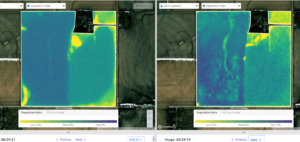
- For late-season diagnosis see the following photo.
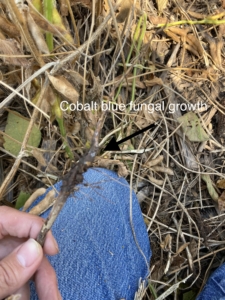 Not the best quality, but want to point out the cobalt blue fungal growth on the root system from SDS.
Not the best quality, but want to point out the cobalt blue fungal growth on the root system from SDS. - For more info see the following link….Sudden Death in Soybeans
- Dectes Stem Borer. Recently found our second incidence of Dectes Stem Borer just SW of Elgin. Not much for pressure by present.
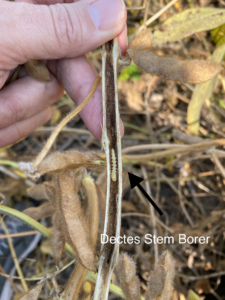 This insect enters the plant at a node and proceeds to ‘hollow out’ the stem leading to early plant death. So far not much one can do in the way of management for this insect yet.
This insect enters the plant at a node and proceeds to ‘hollow out’ the stem leading to early plant death. So far not much one can do in the way of management for this insect yet. - For more info see the following link….Dectes Stem Borer in Soybeans
- Lodged Beans….now what? With the storms and rain of the past two weeks, most all soybean fields have lodged. Some area fields were lodging already at the beginning of August. Typically, if you see lodged soybeans White Mold usually tags along with it and this is the case this year. We are seeing heavier amounts of White Mold this year than the past 3-4 years. So far we like the tolerance for White Mold that we are seeing in the Pioneer soybean lineup compared to many competitor hybrids. For more White Mold recommendations click here
- How do we improve efficiency for harvesting lodged soybeans? How much yield are you losing from lodging? How do you minimize harvest losses?To find these answers click the following link on Lodge Soybean Recommendations
2021 Yield Data
Please check this website throughout harvest and this winter for local area yield data. We will continue to text yield results as they come out, but they will also get posted here for timely and organized viewing. The data will be under Ag Update – Harvest Data. Please contact us if you would like help calibrating your yield monitor and/or want a yield check!
Thanks for giving us the opportunity to be a part of your farming operation!
Starman Seed Service, Inc.

